Is it possible to get rid of cellulite?
 Cellulite is a natural phenomenon that’s more commonly seen in women. It appears when normal fat pushes up between the connective tissue bands, causing the skin to have a dimpled or cottage cheese appearance. Cellulite most commonly forms on the thighs, hips and buttocks, but can also be seen on the abdomen, breasts and upper arms.
Cellulite is a natural phenomenon that’s more commonly seen in women. It appears when normal fat pushes up between the connective tissue bands, causing the skin to have a dimpled or cottage cheese appearance. Cellulite most commonly forms on the thighs, hips and buttocks, but can also be seen on the abdomen, breasts and upper arms.
Cellulite isn’t a serious medical condition and doesn’t cause pain or discomfort. It’s unclear why cellulite forms. Cellulite is neither a measure of obesity nor a sign of excess fat. It can affect those with ideal body weight as well as those who may be overweight.
Cellulite can worsen with weight gain, pregnancy, lack of physical activity, hormonal changes and poor nutrition. Heredity and genetics play a role as well in the formation of cellulite, as does the natural aging process with the loss of skin elasticity.
Unfortunately, there’s no cure or way to prevent this normal skin change. Maintaining a healthy lifestyle with proper diet, exercise and hydration helps with overall skin health. Techniques to improve cellulite may provide temporary benefit, but there’s no long-term effective treatment for cellulite. Here’s a rundown of the options:
Weight loss: Weight loss through improved nutrition and exercise can be helpful, particularly with the increase in activity and improved muscle tone with weight-bearing exercises. But even millions of abdominal crunches, squats and leg lifts won’t cure cellulite.
Lasers: Lasers targeting fat cells is an evolving therapy, but there doesn’t appear to be any long-term benefit.
Liposuction: Liposuction involves removal of fat cells by suctioning them out via a narrow tube that’s inserted under the skin. Liposuction does require local anesthesia and will often result in drainage from the small incisions, with a fair amount of post-procedure discomfort. While it can enhance shape and body contouring, liposuction potentially could make cellulite more prominent with increased dimpling with the loss of the fat between the connective tissue cords. It’s better as targeted therapy for fat removal, rather than a cellulite treatment.
Fat freezing: Fat freezing or cryolipolysis involves the freezing of the lipids in the fat cells as a way of “dissolving” fat. It helps diminish fat accumulation, but the cords remain present. It requires multiple treatments in order to dissolve significant fat content. The issue is the loss of fat may make dimpling more apparent.
Prescription and over-the-counter creams: Topical prescription creams are limited in their effectiveness. Of any available on the market, only tretinoin may help the dimpled appearance with increased collagen and elastin production, but only with long-term and consistent usage. Other over-the-counter creams, such as methylxanthine and herbal creams, don’t provide the promised benefit.
Cellulite is more noticeable on lighter skin versus darker skin, so self-tanners or skin bronzers can help camouflage the dimpling of the skin but not cure it.
Massage: Deep tissue massage is a massaging and rolling technique to enhance lymphatic drainage. It’s a non-invasive treatment option, but it requires multiple treatments for any noticeable results. The benefit may be more related to redistribution of fat rather than any permanent removal of fat. Any improvement would be temporary and related to fluid shifts, and would require ongoing treatments.
Radiofrequency: Radiofrequency uses an electrical current in an effort to stimulate collagen production and decrease fat cell production. It’s a non-invasive, virtually pain-free option. Radiofrequency does require multiple treatments for benefit and needs routine maintenance treatment.
Subcision: Subcision involves the release of the connective tissue bands with a needle, targeting the fibrous bands that cause the skin to dimple, while other techniques focus on the removal of the fat. The devices used for subcision offer minimally invasive techniques that help break these fibrous bands that are tethering the skin. It often requires a few weeks downtime, but with more long-term benefit than other techniques.
Susan Massick is a dermatologist at The Ohio State University Wexner Medical Center. You can find her on Twitter: @SusanMassickMD




